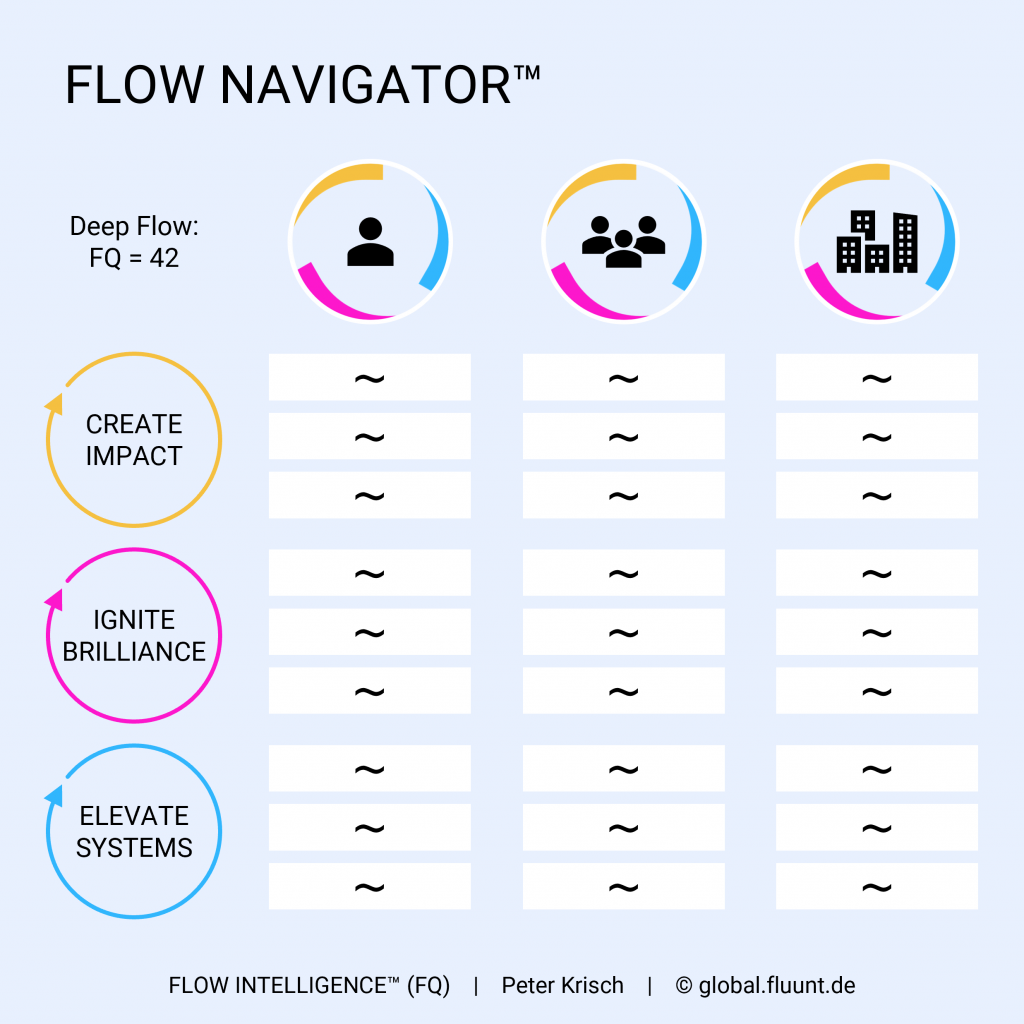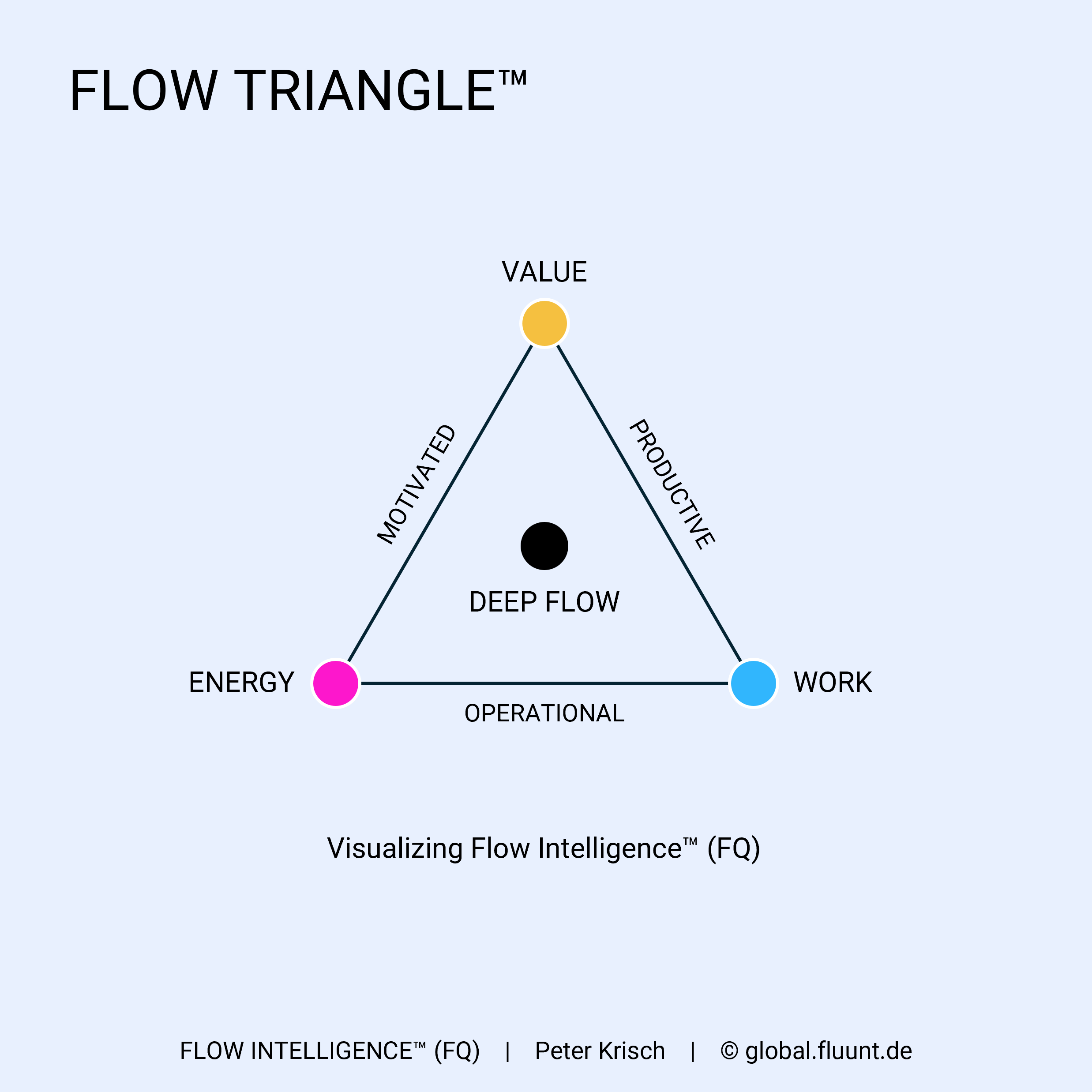Frameworks strengthen parts of an organization. Flow Intelligence™ strengthens the whole. Flow Intelligence™ (FQ) is the enterprise capability to sense how Value, Work, and Energy move across an organization. It helps leaders and teams recognize flow and friction patterns, understand what the system needs, and steer based on what is happening now. When the Flow of Value, Flow of Work, and Flow of Energy reinforce one another, organizations reach a state we call Deep Flow — clarity, coherence, and frictionless execution.



Flow Intelligence moves you from outcomes to 🚀 outperformance.
Why Flow Intelligence™?
Most organizations use multiple frameworks or standards such as SAFe® 6.0, LeSS, Flight Levels®, Team Topologies, Scrum, Kanban, PMI PMBOK® 8, IPMA® ICB4, PRINCE2® 7, and ITIL® 4. Each contributes value, but each also adds its own language, practices, and complexity.

Flow Intelligence™ solves this by giving organizations:
- One shared lens across teams, functions, and frameworks
- A way to see actual flow, not just ceremonies or outputs
- A system-level understanding of alignment and friction
- A leadership model guided by Flow Signals (~) as they happen
It brings clarity and coherence where frameworks alone are not enough.
Flow Intelligence transforms scattered practices into a 🔗 cohesive capability.
The Flow Triangle™ – Make Flow Visible
Flow Intelligence™ is built on three essential flows:
- Flow of Value
Do strategy, priorities, and decisions lead to meaningful outcomes? - Flow of Work
Does work move smoothly through the system — across teams, handoffs, and dependencies? - Flow of Energy
Do people have the focus, motivation, and psychological capacity to sustain performance?
When these flows align, organizations become fast, adaptive, and resilient — without burnout or chaos.

The Flow Triangle™ shows how your organization balances Value, Work, and Energy. A dot inside the triangle visualizes the current flow pattern:
- Operational (Work–Energy edge)
Teams are busy and active, but impact is unclear.
“Busy but not impactful.” - Productive (Value–Work edge)
Output is strong, but energy is low.
“We hit the goals, but people feel drained.” - Motivated (Value–Energy edge)
People are engaged and enthusiastic, but execution is inconsistent.
“Humanly driven but not operationally grounded.”
A centered dot signals reinforcing flows and strong potential for Deep Flow.
Taking care of Enterprise Flows creates a 🌊 wave of momentum.
The Flow Lens™ – Your Enterprise Radar
The Flow Lens™ is a simple, framework-neutral radar that scans how value, work, and energy moves — through Flow Signals (~).

It reveals patterns of flow, friction, tension, and alignment as they happen, without requiring dashboards or complex analytics. Leaders and teams use the Flow Lens™ to build a shared picture of how the system behaves in the moment
Flow Intelligence favors ☘️ simplicity over framework perfection.
The Flow Navigator™ – Turn Insight Into Action
Insight only matters when it leads to meaningful action. The Flow Navigator™ translates Flow Intelligence™ into practical, targeted interventions.

It is built from:
Three Flow Principles
- Create Impact (Value)
- Ignite Brilliance (Energy)
- Elevate Systems (Work)
Three Dimensions
- Individual
- Team
- Organization
Each principle × dimension intersection highlights a leverage point where flow can be strengthened. We recommend at least nine defined Flow Levers per Dimension
Flow Intelligence is a 💡capability you build, not another framework or method.
The Deep Flow Scan™
The Deep Flow Scan™ is our signature diagnostic. It combines the Flow Lens™, Flow Triangle™, and Flow Navigator™ into one coherent assessment. You receive:
- Flow Signals across all three flows
- A dot position on the Flow Triangle™
- A Deep Flow Indicator™
- Your Flow Quotient (FQ)
- Clear, framework-neutral recommendations
The Deep Flow Scan™ works for digital product organizations, SAFe® implementations, project portfolios, and leadership teams.
Flow Quotient (FQ = 42)
To make enterprise flow tangible, we use one simple score: Flow Quotient (FQ), with a maximum of 42.
Inspired by the “ultimate answer” in The Hitchhiker’s Guide to the Galaxy, FQ = 42 represents a Deep Flow Enterprise, an organization that can sense itself, align naturally, and operate with coherence. As FQ rises, the system becomes clearer, calmer, and more capable, without adding unnecessary process or overhead.
Deep Thought. Deep Flow. 🚀 FQ = 42.
Leading by Flow Signals
Flow Intelligence™ makes an essential distinction.
- Flow Signals (~) show how the system behaves: tension patterns, stuck work, rising overload, misalignment, and energy leaks. They give leaders awareness of flow and friction as it happens — not months later in reports.
- Flow States show how people experience that behavior across the organization’s three dimensions:
- Individual Flow State
Personal focus, clarity, and immersion. - Team Flow State
Collective synchrony and seamless collaboration. - Organizational Flow State
System-wide clarity, aligned energy, and coherent execution — the hallmark of a Deep Flow Enterprise.
- Individual Flow State
Flow Signals reveal what’s happening. Flow States reveal how it feels across the individual, team, and organizational dimensions. Together, they enable a shift from Management by Objectives and OKRs to Leading by Flow Signals, a more adaptive and reality-based leadership approach.
Flow Intelligence enables constructive 💬 dialogue about hidden constraints.
Where AI Helps — and Where It Creates Noise
As AI becomes part of everyday work, organizations face a new challenge: AI accelerates everything… including friction.
Without Flow Intelligence™, AI creates AI noise:
- more content
- more messages
- more dashboards
- more recommendations
- more tasks
- more decisions
- more cognitive load
This overwhelms teams and fragments alignment. Flow Intelligence™ prevents AI noise by giving organizations the ability to sense what actually matters:
- The Flow Lens™ filters AI output through the lens of Value, Work, and Energy.
- Flow Signals highlight the patterns that need attention, and ignore those that don’t.
- The Flow Navigator™ shows where AI can genuinely strengthen flow, instead of adding more noise.
- Deep Flow frees cognitive capacity, so AI becomes a multiplier instead of a burden.
AI accelerates sensing. Flow Intelligence™ accelerates understanding. Together, they create clarity — not overload.
This makes AI adoption healthier, more strategic, and more sustainable.
Flow Intelligence™ prevents 🤖 AI noise.
Bring Flow Intelligence™ to Your Organization
Whether you’re scaling product development, leading a transformation, or strengthening organizational health, Flow Intelligence™ gives you a practical way to understand and improve how the system truly works. We partner with organizations ad interim or as strategic sparring partners to implement:
- Flow Triangle™
- Flow Lens™
- Flow Navigator™
- Deep Flow Scan™
…in a way that fits your context, not the other way around.
Ready to explore Flow Intelligence™? Let’s talk.





